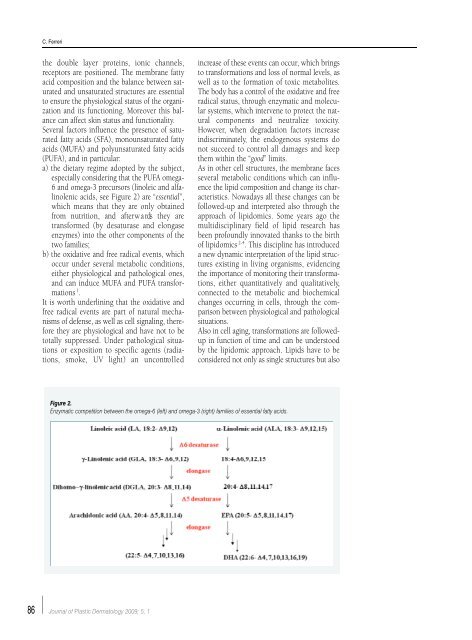Vol. 5, n. 1, January-March 2009 1th International ... - Salute per tutti
Vol. 5, n. 1, January-March 2009 1th International ... - Salute per tutti
Vol. 5, n. 1, January-March 2009 1th International ... - Salute per tutti
You also want an ePaper? Increase the reach of your titles
YUMPU automatically turns print PDFs into web optimized ePapers that Google loves.
86<br />
C. Ferreri<br />
the double layer proteins, ionic channels,<br />
receptors are positioned. The membrane fatty<br />
acid composition and the balance between saturated<br />
and unsaturated structures are essential<br />
to ensure the physiological status of the organization<br />
and its functioning. Moreover this balance<br />
can affect skin status and functionality.<br />
Several factors influence the presence of saturated<br />
fatty acids (SFA), monounsaturated fatty<br />
acids (MUFA) and polyunsaturated fatty acids<br />
(PUFA), and in particular:<br />
a) the dietary regime adopted by the subject,<br />
especially considering that the PUFA omega-<br />
6 and omega-3 precursors (linoleic and alfalinolenic<br />
acids, see Figure 2) are “essential”,<br />
which means that they are only obtained<br />
f rom nutrition, and afterw a rds they are<br />
transformed (by desaturase and elongase<br />
enzymes) into the other components of the<br />
two families;<br />
b) the oxidative and free radical events, which<br />
occur under several metabolic conditions,<br />
either physiological and pathological ones,<br />
and can induce MUFA and PUFA transformations<br />
1 .<br />
It is worth underlining that the oxidative and<br />
free radical events are part of natural mechanisms<br />
of defense, as well as cell signaling, therefore<br />
they are physiological and have not to be<br />
totally suppressed. Under pathological situations<br />
or exposition to specific agents (radiations,<br />
smoke, UV light) an uncontro l l e d<br />
Journal of Plastic Dermatology <strong>2009</strong>; 5, 1<br />
increase of these events can occur, which brings<br />
to transformations and loss of normal levels, as<br />
well as to the formation of toxic metabolites.<br />
The body has a control of the oxidative and free<br />
radical status, through enzymatic and molecular<br />
systems, which intervene to protect the natural<br />
components and neutralize toxicity.<br />
However, when degradation factors increase<br />
indiscriminately, the endogenous systems do<br />
not succeed to control all damages and keep<br />
them within the “good” limits.<br />
As in other cell structures, the membrane faces<br />
several metabolic conditions which can influence<br />
the lipid composition and change its characteristics.<br />
Nowadays all these changes can be<br />
followed-up and interpreted also through the<br />
approach of lipidomics. Some years ago the<br />
multidisciplinary field of lipid research has<br />
been profoundly innovated thanks to the birth<br />
of lipidomics 2-4 . This discipline has introduced<br />
a new dynamic interpretation of the lipid structures<br />
existing in living organisms, evidencing<br />
the importance of monitoring their transformations,<br />
either quantitatively and qualitatively,<br />
connected to the metabolic and biochemical<br />
changes occurring in cells, through the comparison<br />
between physiological and pathological<br />
situations.<br />
Also in cell aging, transformations are followedup<br />
in function of time and can be understood<br />
by the lipidomic approach. Lipids have to be<br />
considered not only as single structures but also<br />
Figure 2.<br />
Enzymatic competition between the omega-6 (left) and omega-3 (right) families of essential fatty acids.

















